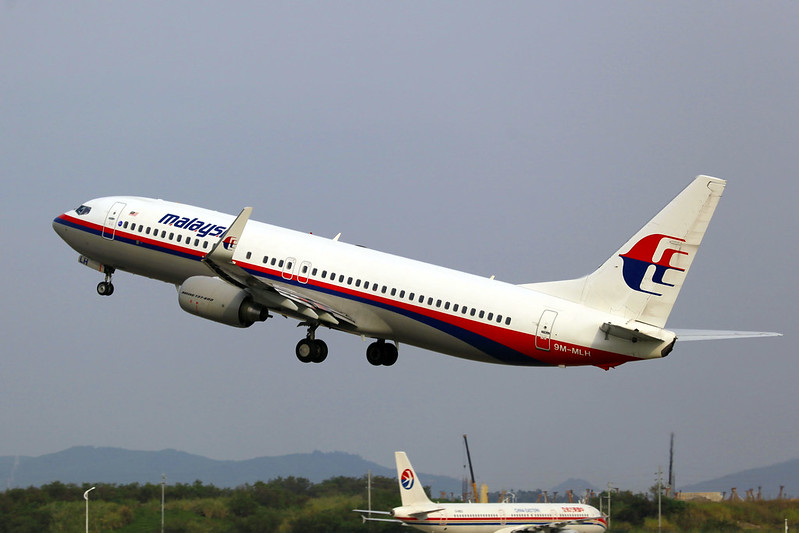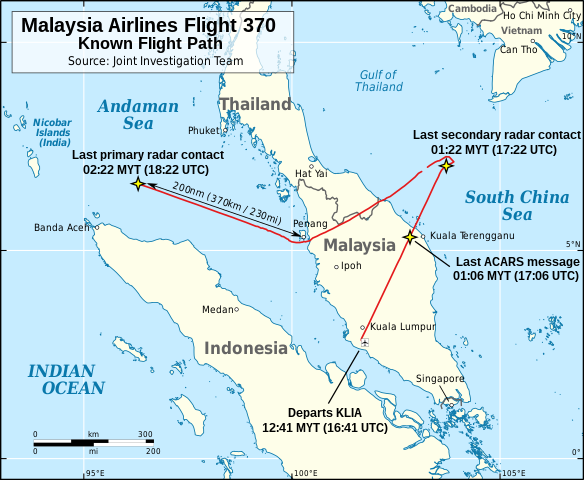
With approximately 8,000 aeroplanes in the sky at any given moment, tracked meticulously from takeoff to landing, it begs the question as to how a scheduled flight can seemingly vanish into thin air, leaving a suspicious lack of evidence even 10 years later.
The mystery unfolded in the early hours of March 8th 2014 when a standard red eye flight departing from Kuala Lumpur took off shortly after midnight, bound for Beijiing. Flight 370 was captained by experienced Zaharie Ahmad Shah who was known as being one of the most respected pilots for Malaysia Airlines and the first officer was 27 year old Fariq Hamid who was close to obtaining his full certification.
There were no problems noted during the first 40 minutes of the flight until MH370 reached the end of Malaysian airspace. It’s important to recognise that all commercial aeroplanes are supposed to be known, reachable and trackable at all times during a flight but as MH370 entered Vietnamese airspace, Captain Shah should have checked in with Ho Chi Minh and he didn’t. On the last radio from Malaysian Air Traffic Control, Shah can be heard answering: “Good night. Malaysian three-seven-zero.”
The aeroplane was never heard from again. It dropped off all radars and prompted a scrambling search and rescue for 239 people that had left no trace. It left even the aviation experts scratching their heads in confusion as to what may have come to pass for flight MH370.
Conspiracy theories were quick to be kicked up out of the dust, concerning a hijacking, the plane being shot down, a fire onboard or even suggestions as outlandish as an alien interference.
Generally, the most accepted explanation from experts stems from the fact that MH370 did in fact continue to appear for six more hours via a geostationary Indian Ocean satellite which is operated by a London-based company called Inmarstat. Seven electronic blips were indicated on this satellite and they showed that the MH370 turned southward once it reached the Andaman Sea, flew in this direction until it ran out of fuel and crashed somewhere between south-western Australia and Antarctica. There would have been no reason for Shah to follow this flight path but evidence from his home flight simulator suggested that it was a route he had practised before flight MH370. Also, the plane’s transponder, responsible for providing regular location updates, had been manually switched off in order to cause it to disappear from radar. For this reason, it was generally accepted that Captain Shah had deliberately taken the plane off course to crash it.

A plethora of other theories surround this case, some more plausible than others but, save for some debris that washed up along the coast of Africa and on islands in the Indian Ocean, there is still no evidence to suggest that we will ever know what became of Malaysian Airlines Flight 370.
In the early days after the crash, Malaysian crash investigators proposed that the International Civil Aviation Organisation (ICAO) make it mandatory for commercial aircraft to be fitted with real-time tracking systems to make sure that there is always enough information on hand to locate planes during their distress calls and attend to the problem in a timely manner.
10 years on however, the aviation industry still hasn’t fully adopted this system as proposed by Malaysia although GADSS has been developed (Global Aeronautical Distress and Safety System) which requires airlines to install an automated reporting system on all new planes that sends out regular updates on their locations (in intervals of 15 minutes.)
Colin Weir, group chief executive of Flight Safety, an Australian-based aviation safety consultancy, said: “If we take 15 minute intervals for a plane travelling at 800 kilometres per hour, that brings it down to a 200 kilometre diameter search area. If it’s down to one minute, that will narrow the search area by 15 times…” He went on to say that this would mean search and rescue teams could get into the general area while all systems are activated to relay an emergency.
A whole decade has passed and families are still fighting for answers. As of November 2023, 40 relatives of passengers have made an appeal for a new investigation and have claimed compensation from aircraft manufacturer Boeing, engine maker Rolls Royce and Allianz insurance group.
They have also written a letter to the Malaysian Prime Minister, Anwar Ibrahim, stating that they are eager to begin searching for the plane on their own and “are willing to invest their own money or co-operate with capable individuals and companies.”
Bao Lanfang had a son, daughter-in-law, and granddaughter who were all passengers on the flight and he says he cares more about answers than compensation.
He says: “What I want is that Malaysia Airlines gives me the truth. What happened to our loved ones?”
Each family filed for civil compensation in a Chinese court of between 10 million yuan and 80 million yuan which is around one million to eight million pounds as well as extra compensation that covers moral damages. The families of more than 110 other passengers have already reached their own settlements.
Malaysia’s transport ministry and Malaysia Airlines both declined to comment on the hearing whose jurisdiction to enforce compensation against the defendants is not clear.
For now, it appears that if families wish to continue seeking answers, they are largely on their own. The vast areas of the Indian Ocean that are unchartered make searching for possible debris nearly impossible.
For now, it appears that if families wish to continue seeking answers, they are largely on their own.
We can only hope that GADSS has been a positive to come out of this tragedy and that with this, we can avoid the chance of allowing another commercial jet to simply vanish into thin air.


